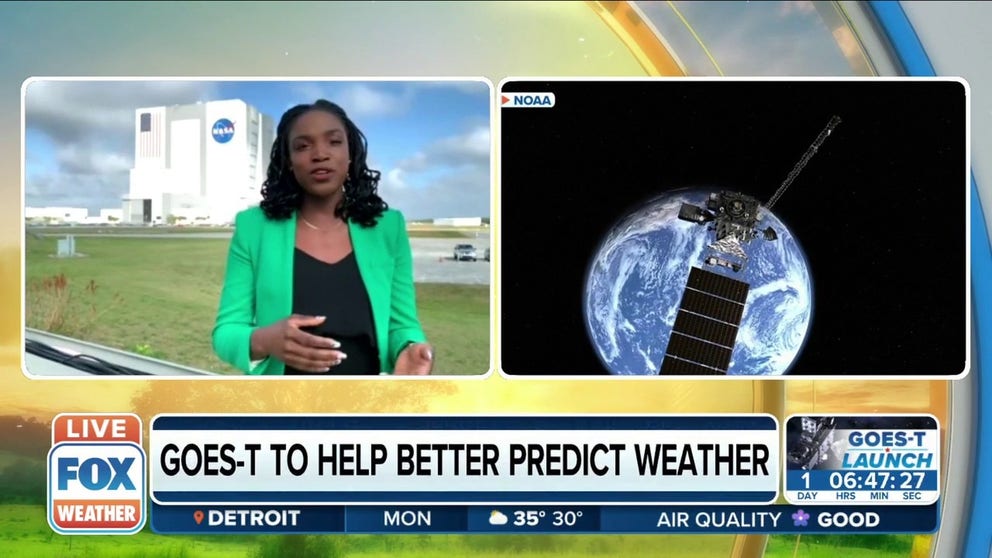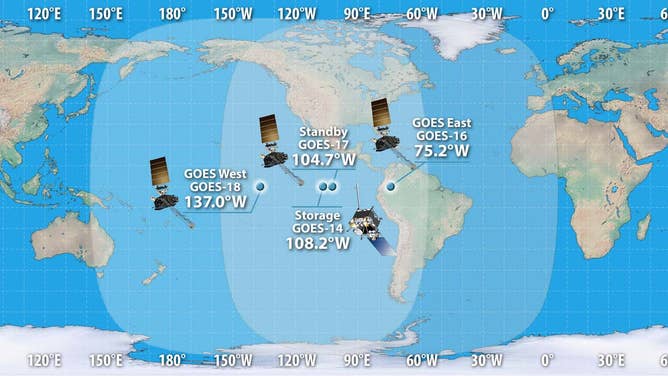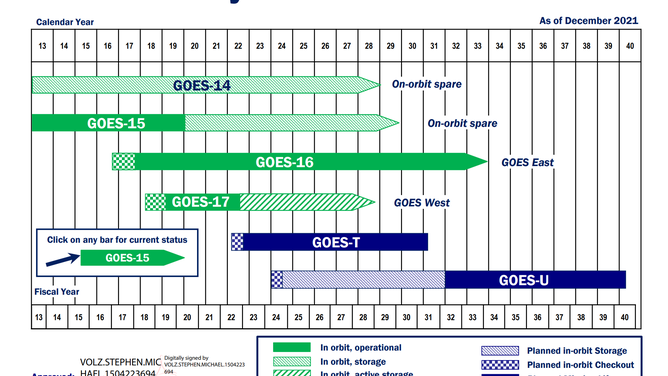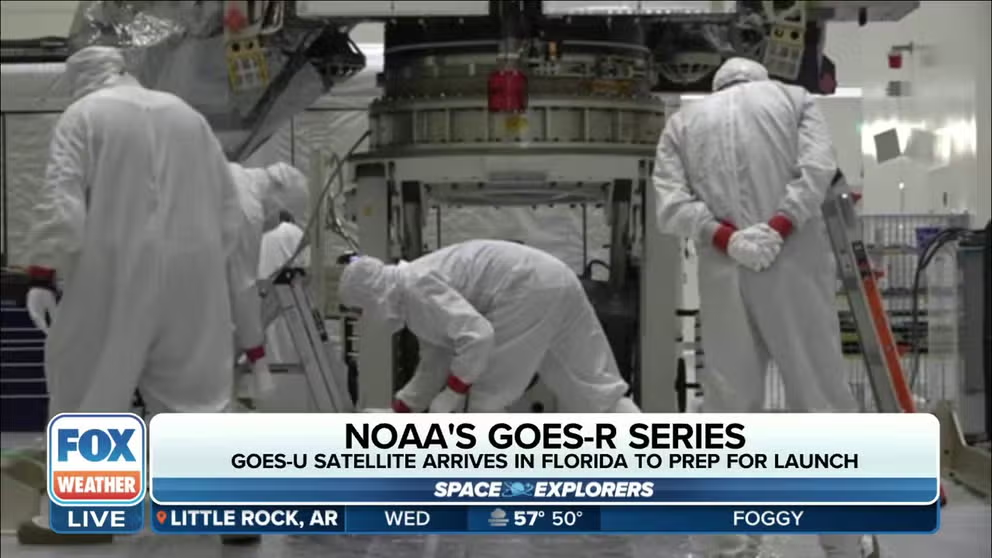GOES-U weather satellite to launch June 25 after leak causes delay
GOES-U will be the fourth and final satellite in NOAA's GOES-R Series weather satellite. It includes NOAA's first Compact Coronagraph, which will watch the Sun.
GOES-T satellite will help better predict the weather
File: Tewa Kpulun, Geostationary Lightning Mapper (GLM) Science Lead at Lockheed Martin, explains how the GOES-T satellite will help better predict the weather. GOES-U will be the final satellite to make up the GOES-R Series Program.
KENNEDY SPACE CENTER, Fla. – NOAA and SpaceX have finally set a date to launch the last satellite of the GOES-R Series into geostationary orbit on June 25 after a lengthy delay due to a rocket booster leak.
NOAA called this launch "monumental" and claimed its network of Geostationary Operational Environmental Satellites is "the nation's most advanced weather observing and environmental monitoring satellite system."
GOES-U is the fourth and last satellite to join the series. Once in orbit, it will be renamed GOES-19. From 22,236 miles above the equator, GOES-19 will continuously observe weather systems across the Western Hemisphere. It will replace GOES-16 in the GOES-East orbit.
The view from GOES-East and West stretches from the west coast of Africa to New Zealand and from near the Arctic Circle to the Antarctic Circle, according to NOAA.
THE MORE YOU GOES: 7 THINGS TO KNOW ABOUT NOAA'S NEW WEATHER SATELLITE
"Having that rapid information and clarity that we’re getting in the new instrumentation, it’s just a game changer for the forecasters," said Ken Graham, director of the National Weather Service and former director of the National Hurricane Center.
The April launch of GOES-U was scrubbed after scientists found a liquid oxygen leak in a Falcon Heavy booster. SpaceX's Falcon Heavy rocket uses three Falcon 9 first-stage boosters to provide the 5 million pounds of thrust needed to launch off the planet.
FOX Weather was there when the school-bus-sized satellite arrived in Florida in January.
SMILE! FIRST IMAGES ARRIVE FROM NEW GOES-18 WEATHER SATELLITE
NASA satellite program aims to help forecasters better predict weather events
FOX Weather's Brandy Campbell was at Florida's Space Coast for the arrival of a GOES-U satellite that is being prepared for launch.
New technology on GOES-U to monitor solar storms
GOES-U will carry something new to space. It is the only Series-R satellite with a Compact Coronagraph. This third instrument on the craft is a solar telescope that will image the outer layer of the Sun's atmosphere. It will be NOAA's first solar coronagraph.
"That's where extreme space weather events originate," explained Elsayed Talaat, the director of the Office of Space Weather Observations.
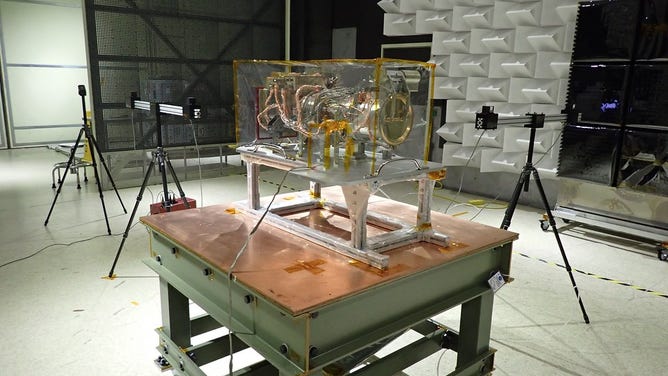
The Compact Coronagraph is a space weather instrument that images the solar corona (the outer layer of the sun’s atmosphere) and helps detect and characterize coronal mass ejections.
(NOAA / NASA)
"It's very important for us to measure space weather effects and be able to model and provide warnings, forecasts and alerts, for space weather, to protect our technological society," Talaat said. "Having that data allows us to more reliably predict when these large solar storms are going to, how they propagate towards Earth, and whether or not they're going to affect us here on Earth in a significant way."
Last Sunday, NOAA issued a Geomagnetic Storm Warning. The "severe G4" storm directed energy at the Earth and threatened power grids, satellites and communication and navigation systems.
SOLAR SUPERSTORM COULD ‘WIPE OUT THE INTERNET’ FOR WEEKS OR MONTHS, SCIENTIST SAYS
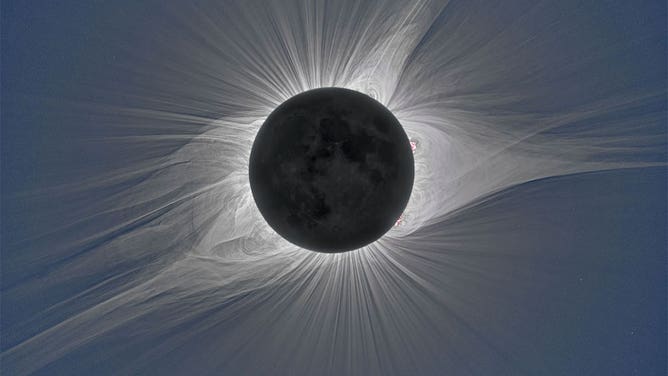
File: A photograph of the corona taken during the Aug. 21, 2017 total solar eclipse.
(Miloslav Druckmüller, Peter Aniol, Shadia Habbal/NASA Goddard, Joy Ng / NASA)
Other forecasting game changers
With a suite of seven instruments, including the Advanced Baseline Imager (ABI), the satellite will monitor hurricanes and weather patterns at high resolution every 30 seconds.
"It has a very large focal plane. And what that does for the instrument is it can look at very wide areas of Earth. And so because it can do that, it can scan very, very fast," Pam Sullivan, director of NOAA's Office of Geostationary Earth Orbit Observations, said in a statement. "What that means for the forecasters is they can look at a storm or other area of interest as often as once every 30s. And when you can do it that fast, you know, the forecasters are really seeing that data in real time."
GOES-U also has a Geostationary Lightning Mapper.
"It could actually distinguish between sort of your average lightning strike and the ones that are more dangerous, the ones that are continuing-current, and those are very long lightning strikes that are most likely to cause a fire," said Sullivan.
SATELLITE TECHNOLOGY AIDED IN ESTABLISHING TWO NEW WORLD RECORDS FOR MEGAFLASHES OF LIGHTNING
Graham calls lightning detection a key to early warnings for the fire weather community.
In the next decade, NASA and NOAA are planning for the next-generation weather satellites known as the Geostationary Extended Observations, or GeoXO. NOAA and NASA plan to begin launching the GeoXO series in the 2030s.
